Meaning of Indifference Curve
An indifference curve is the locus of all those combinations of two goods that yields the same level of utility (satisfaction) to the consumer so that the consumer is indifferent to purchase the particular combination s/he selects.Such a situation arises because a consumer consumes a large number of goods and services. Often he finds that one commodity serves as a substitute for another. This allows him to substitute one commodity for another. In this case, he can make various combinations of two goods that give him the same level of satisfaction.
When a consumer faces such combinations of goods, he/she would be indifferent between the combinations. When such combinations are plotted graphically, it gives a curve. This curve is known as the indifference curve. It is also called the iso-utility curve or equal utility curve.
According to Anna Koutsoyaiannis, “An indifference curve is the locus of points-particular combination or bundles of goods, which yields the same utility (i.e, satisfaction) to the consumer so that he is indifferent as to the particular combination he consumes”.
The satisfaction derived from the indifference curves that are in between IC1 and IC2 is less than the higher indifference curve IC1 and more than the lower indifference curve IC2.
According to Anna Koutsoyaiannis, “An indifference curve is the locus of points-particular combination or bundles of goods, which yields the same utility (i.e, satisfaction) to the consumer so that he is indifferent as to the particular combination he consumes”.
Indifference Schedule:
A table that shows the various combinations of two goods that yield the same level of satisfaction to the consumer is called indifference schedule. The table below is an example of an indifference schedule that shows 5 different combinations A, B, C, D, and E of two goods X and Y. All these combinations yield the same level of satisfaction to the consumer. Therefore, the consumer is indifferent between them.
Indifference schedule:
|
Combinations |
Commodity-X |
Commodity-Y |
|
A |
1 |
14 |
|
B |
2 |
10 |
|
C |
3 |
7 |
|
D |
4 |
5 |
|
E |
5 |
4 |
Indifference Curve/ Diagram/ Graph:
All the combinations of X and Y showed in the table above, give the same level of satisfaction to the consumer. The indifference schedule, when plotted on a graph, gives an indifference curve as shown in the figure below:
In the above figure, commodity X is measured on X-axis and commodity Y is measured on Y-axis. IC represents an indifference curve. Points A, B, C, D, and E show combinations of X and Y commodities that give the same level of satisfaction to the consumer. If we join these points, we get a smooth, convex, and continuous negative sloped curve which is called the indifference curve.
Indifference Map
An indifference map is a set of indifference curves plotted on a single cartesian plane. An indifference map shows different indifference curves which rank the preference of the consumer. Combinations that lie on an indifference curve give the same level of satisfaction to the consumer. However, a higher indifference curve represents a higher level of satisfaction than a lower indifference curve.An indifference curve far from the origin is called higher indifference curve and near to the origin is called a lower indifference curve. An indifference map can be shown as follows:
In the above figure, commodity X is measured on X-axis and Y commodity on Y-axis. The indifference curve shows those combinations of two goods that yield the same satisfaction level. IC3 yields higher satisfaction than IC2. IC1 yields the lowest level of satisfaction. This is because higher IC contains more units of at least one commodity.
Properties or Characteristics of Indifference Curve
The properties or characteristics of the indifference curve are as follows:1. Indifference curve has a negative slope:
An indifference curve slopes downward from left to right, ie, it has a negative slope. A negative slope implies that the two goods are substitutes for one another. Therefore, if the quantity of one commodity decreases, the quantity of the other commodity must increase if the consumer has to stay at the same level of satisfaction.
In the above figure, when the consumer moves from point A to B, the quantity of Y decreases from Y1 to Y2. At the same time, the quantity of X increases from X1 to X2 keeping the level of satisfaction the same. The same thing happens as the consumer moves from point B to C. But the decrease in Y i.e. Y2Y3 is less than Y1Y2 and the increase in X, ie. X2X3 is equal to X1X2.
2. Indifference Curve is Convex to the origin:
Indifference curves for normal goods are convex to the origin. This implies that the two goods are imperfect substitutes for one another and the marginal rate of substitution between the two goods decreases as a consumer moves along an indifference curve. Diminishing marginal rate of substitution means that as the quantity of X is increased by an equal amount then that of Y diminishes by a smaller amount.
In the above figure, the indifference curve is convex to the origin. Convexity of indifference curve implies diminishing slope because consumer gives up less and fewer units of Y to have an equal additional unit of X. The slope of the IC curve measures the marginal rate of substitution (MRS). Therefore, MRS also diminishes.
3. Indifference curves neither Intersect nor become tangent to one another:
If two indifference curves intersect or are tangent to each other, it means that an indifference curve indicates two different levels of satisfaction. If two indifference curves intersect, it violates consistency or transitivity assumption.
Let us suppose that the two indifference curves IC1 and IC2 intersect to each other at point C. Point C lies on both indifference curves where points A and B lie on IC1 and IC2 curves respectively. Points A, B, and C represent three different combinations of commodities X and Y. Combination C is common to both the indifference curves. It implies that in terms of utility;
Level of satisfaction at A = Level of satisfaction at C ...... (i)
Again, level of satisfaction at B = level of satisfaction at C ......(ii)
Level of satisfaction at A = Level of satisfaction at C ...... (i)
Again, level of satisfaction at B = level of satisfaction at C ......(ii)
From (i) and (ii), Level of satisfaction at A = Level of satisfaction at B.
If A = B, OM of X + AM of Y = OM of X+ BM of Y.
More Precisely,
In IC1, A = C
In IC2, B = C
Then, A = B, which is absurd because A ≠ B. They are different points on different indifference curves which yield different level of satisfaction.
Since OM of X is common to both the curves, it means that AM of Y is equal to BM of Y. But this is not so in reality because of AM > BM. Therefore, combinations A and B cannot be equal in terms of utility. Therefore, the intersection violates the transitivity assumptions.
Since OM of X is common to both the curves, it means that AM of Y is equal to BM of Y. But this is not so in reality because of AM > BM. Therefore, combinations A and B cannot be equal in terms of utility. Therefore, the intersection violates the transitivity assumptions.
4. Higher indifference curve represents a higher level of satisfaction than the lower ones:
A higher indifference curve represents a higher level of satisfaction than the lower one. The reason is that an upper indifference curve contains a larger quantity of one or both goods than the lower one.
Let us consider three indifference curves IC1 and IC2 and IC3. IC2 is a higher indifference curve than IC1 and IC3 is a higher indifference curve than IC2. Every point that lies on IC2 gives higher satisfaction than that of IC1. Every point that lies on IC3 gives higher satisfaction than that of IC2 because they contain more quantity of both goods (X and Y) than the combinations on lower ICs. Hence, by the assumption of non-satiety, the consumer prefers IC3 to IC2. Similarly, we will prefer any other combination that lies on IC2 than on IC1.
5. Indifference curves are not necessarily parallel:
Another important property of the indifference curve is that Indifference curves are not necessarily parallel. Though indifference curves are falling, negatively sloped to the right, yet the rate of fall will not be the same for all indifference curves. In other words, the diminishing marginal rate of substitution between the goods is not the same in the case of all indifference schedules. Therefore, it is not necessary to be parallel between two indifference curves.
The starting point of IC1 and IC2 is very near in the above figure. When ICs are nearer to X-axis their gap becomes higher and higher. The diminishing marginal rate of substation between X and Y commodity is not equal so IC and IC2 are not parallel.
6. Indifference curve does not touch either of the axes:
If indifference curve IC2 touches X-axis as shown in the figure below at M, the consumer will be having OM of goods X and no Y. Similarly, if an indifference curve IC touches the Y-axis at N, the consumer will be having only ON of good Y and no X. Such curves violate the assumption that the consumer buys two goods in a combination. Therefore, indifference curves do not touch either of the axes.
7. An indifference curve may not necessarily be a straight line:
An indifference curve is not linear or straight-line because the diminishing marginal rate of substitution between two goods may not be the same. One individual may not be giving up the same units of X goods to obtain the same units of goods Y.
An indifference curve may not take the shape as shown in the figure above.
8. Combinations that lie on an indifference curve give the same level of satisfaction:
All the combinations that lie on an indifference curve give the same level of satisfaction. When a consumer consumes a large number of goods and services, he finds that one commodity serves as a substitute for another. This allows him to substitute one commodity for another one. In this case, he can make various combinations of two goods that give him the same level of satisfaction.
In the above figure, all the combination points A, B, C, D, and E yield the same level of satisfaction to a consumer. Furthermore, any combination along this IC gives the same satisfaction as that of combinations A, B, C, D, and E.
9. Two indifference curves include more indifference curves between their gap:
There can be as many indifference curves between the gap or the open space between the indifference curves IC1 and IC2 as shown in the figure below:




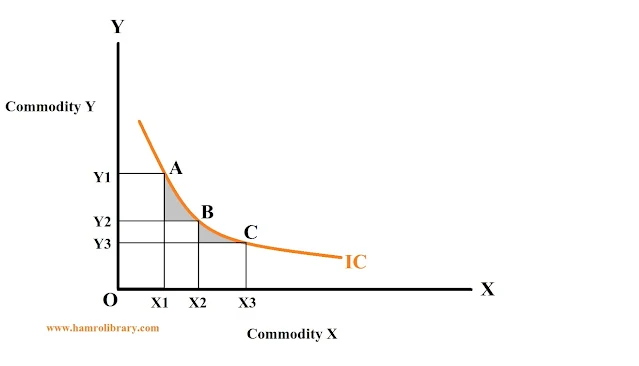

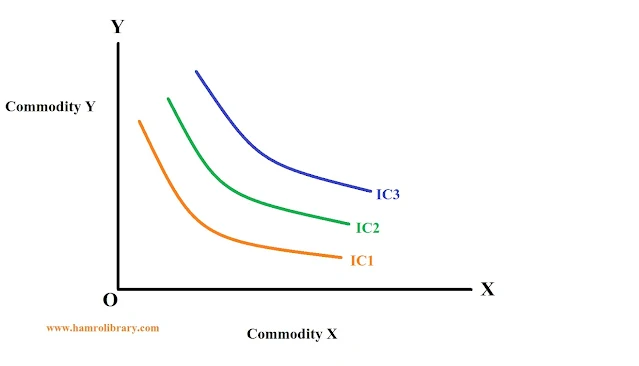
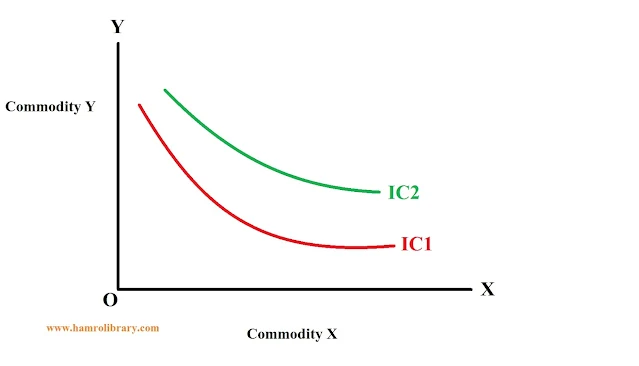
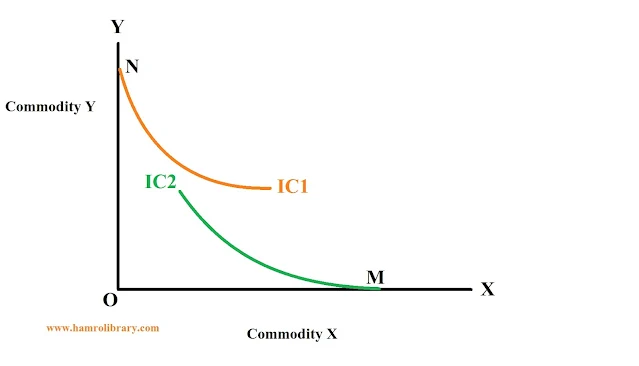
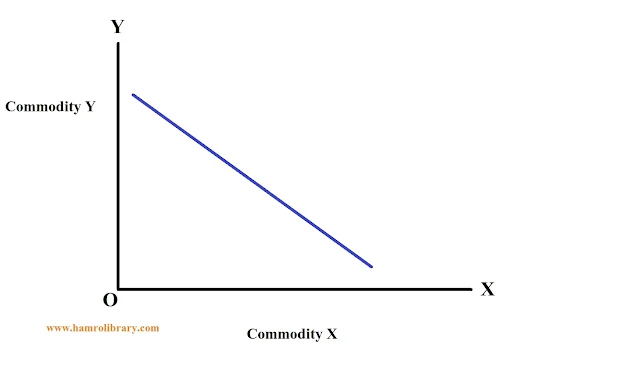
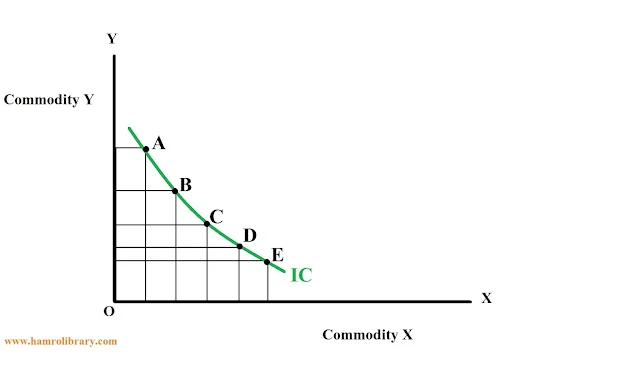

.jpeg)
0 Comments
If this article has helped you, please leave a comment.